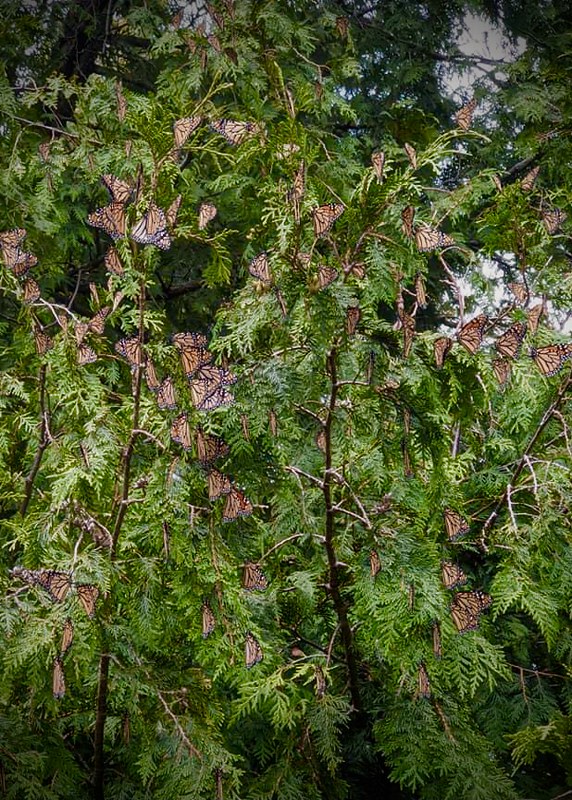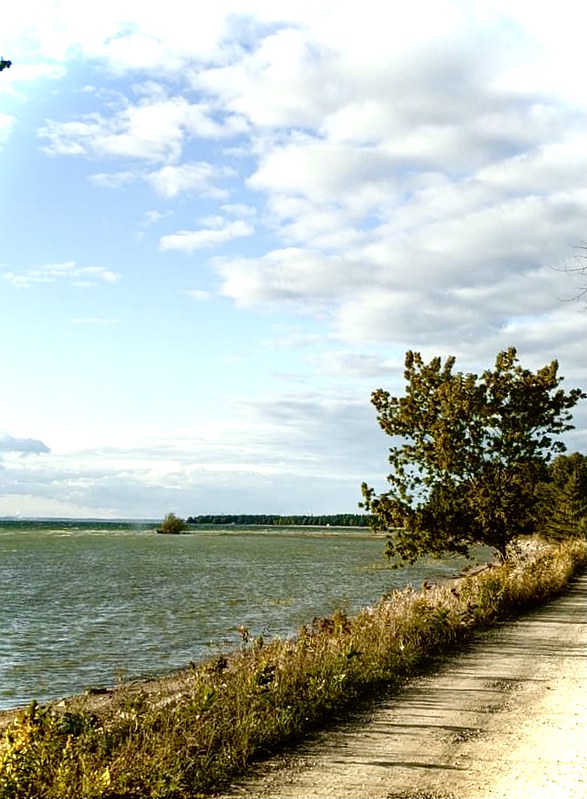By Sue Jamison
September 8, 2021
Just as the Peninsula Point Lighthouse guided ships on Lake Michigan, the Stonington Peninsula guides Monarch butterflies as they begin their 1900-mile journey south to their wintering grounds in the Sierra Madre Mountains of Mexico.
In the fall, thousands of Monarchs can be seen here waiting for favorable conditions to help them cross Lake Michigan. Peninsula Point is one of only a few places in North America where Monarchs can be viewed migrating in large numbers. Because our area is so unique, the Forest Service together with Wildlife Unlimited of Delta County and many volunteers have been conducting research since 1994, making it the oldest data set on the Monarch in North America.
Shorter days and cooling temperatures are signals to the Monarch that it is time to begin flying south. Many of the Monarchs in the Upper Peninsula begin funneling down the Stonington Peninsula, following the shoreline. They will roost on the cedar trees here at Peninsula Point until north winds help them to cross the water over to Door County. Monarchs do not like to fly over large bodies of water. At the tip of the peninsula, they have a short distance to cross the lake.
The cedar trees here protect resting Monarchs from the wind; tall trees are good places for Monarchs to catch the morning sun and warm up. They will often cluster together in “roosting trees” at night on their journey south. The same roosting trees may be used over and over, and no one knows just how or why the Monarchs find the same trees year after year.
From mid-August to mid-September, volunteers check daily to look for increased numbers of Monarchs gathering at the lighthouse. Run exclusively by volunteers, the Monarch Research Project at Peninsula Point includes migration census monitoring and tagging. The information is sent to the University of Kansas. If a tagged Monarch is found in Mexico, it can be brought to a designated area, and they will notify the university which in turn can contact the area in which the Monarch was tagged. In the last 25 years, we have received over 20 certificates letting us know that Monarchs tagged here at Peninsula Point were found in Mexico.
Monarch research on the Stonington Peninsula also includes participation in the Monarch Larva Monitoring Project (MLMP) which is coordinated by the University of Minnesota. Starting in June and continuing until the beginning of September, Monarch caterpillars, also called larva, are monitored in two openings near the lighthouse weekly. Milkweed plants are counted and checked for eggs and any of the five stages of larva. These weekly results are sent to the University of Minnesota. The protocol developed at Peninsula Point, one of the project’s first sites, has been used at other locations across North America.
During the summer breeding season, Monarchs live from 2-6 weeks during which time, they mate and females lay hundreds of eggs. The last generation of the year does not become reproductive and is said to be in “reproductive diapause”. These butterflies are the ones that will migrate to Mexico where they overwinter. The migratory generation has an enormous task ahead of them. Weighing less than a paper clip, these unique butterflies will fly over 1900 miles to a wintering home where they have never been before! They will become reproductive in February and March as they move north, laying eggs on milkweed plants. These Monarchs have lived 8-9 months! As their northward journey continues, there will be two or three generations making their way back north. The Monarchs we see in our area in mid-May may be the 3rd or 4th generation of those Monarchs who left here in September.
The Monarch lays its eggs only on the milkweed plant. The larva then feeds on the leaves, absorbing the “milky white” substance which is toxic to potential predators. Without milkweed, the larva would not be able to develop into an adult butterfly.
Adult Monarchs feed on the nectar from flowers, which contain sugars and other nutrients. Unlike the larva that ear only milkweed, adult Monarchs feed on a wide variety of nectar-bearing flowers.
How can you help the Monarchs?
You can plant milkweed, and you can protect existing milkweed. There is a growing awareness of the importance of milkweed to the Monarch Butterfly. Many areas are letting it grow in fields and along roads and highways
You can plant pollinator plants that monarchs can feed on. Let wildflowers grow and stop using weed killers.
People living in the United States, Canada and Mexico are on a journey that is uniting them under a common goal: the conservation of the Monarch Butterflies. Together we can take care of the land the Monarchs need so that future generations can witness this spectacular sight.












